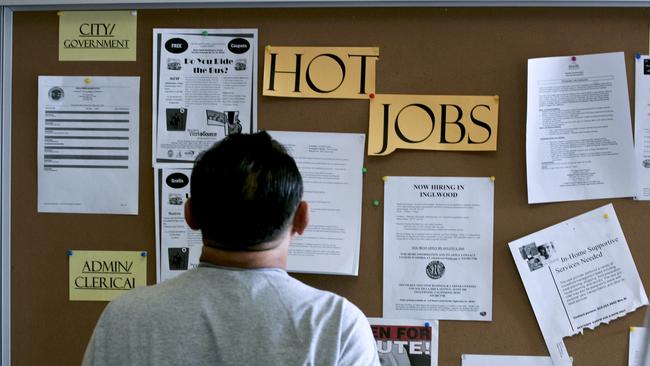Investors need to watch for wage inflation like a hawk
There are more job vacancies in the US than there are unemployed workers – short-term inflation is the key issue for investors.

Inflation, and its eventual resting place, is the topic du jour not least because of its influence on interest rates and, by extension, the discount rate used to value a future dollar of earnings.
History has shown, when economic growth is accompanied by disinflation (declining rates of annual inflation), investors will do very, very well owning the shares of innovative growth companies.
This has been true since the 1970s. More recently, when the global financial crisis wrought its financial havoc on the world, governments and central banks were determined not only to prevent a depression but to position economies for sustainable growth. Despite their most valiant and audacious actions, however, inflation failed to emerge.
The combination proved a boon for many investors, with the best-performing equities being those representing companies with similar characteristics – innovative, disruptive and high growth with pricing power. Bonds also did well.
If some analysts and commentators are to be believed, the picture for such companies may become decidedly unfriendly. And the impact may not be contained to equities. Property could also take a hit.
According to Schroders Economics Group, the supply chain bottlenecks referred to by US Federal Reserve chairman Jerome Powell, in April, are having real consequences.
The global backlog of work has surged to levels unseen since 2004, while delivery times are now the longest ever.
A supply chain “disaster”, that might have its roots in the just-in-time inventory management system invented by the Japanese in the 1980s and since copied religiously, is getting worse.
The global semiconductor microchip shortage could extend to 2023, while Chinese production of power-intensive metals, such as aluminium and magnesium, has been reduced to conserve electricity and to meet pollution targets. Aluminium production in China has declined by 2.3 million tonnes since power rationing began in September.
If car manufacturers were already struggling to meet consumer demand with a chip shortage, the situation can only worsen with the reduction in aluminium available to press panels.
And try buying a bicycle, headphones, furniture or lighting; you will discover extensive delays, unfulfilled delivery promises and the disappointment of refunds.
For manufacturers, costs must be rising. Witness, for example, the near doubling in the price of aluminium since June last year to its highest level in 13 years. Manufacturers may attempt to recoup the higher costs by raising prices. We are seeing this feed through in the building and construction industry.
Sure, consumers cannot spend money on goods that don’t exist, which helps support a high savings rate, but ultimately the supply shortages result in competition for remaining goods, which drives up their prices.
References to “bottlenecks” and “backlogs” suggest a temporary situation. That transitory picture is the one Powell painted in April and the one on which he hung his hat for keeping interest rates low.
But the longer the bottlenecks last, the less dovish central banks will remain.
That’s because the employment picture doesn’t appear to be improving. Wages in some employment sectors are now also rising strongly in Europe and the US.
Job vacancies are also soaring as businesses advertise for jobs that remain unfilled. US job vacancies of more than 10 million are greater than the total number of people currently unemployed. From tech companies including IBM and Cisco, to major healthcare providers and thousands of small businesses, all are besieged with job vacancies, unable to expand and uncertain about whether to invest.
Schroders notes the possibility the US workforce has shrunk since the Covid-19 crisis. Many employees sidelined by the pandemic have failed to return to work. Pointing to three million fewer workers participating in the US workforce than before the pandemic, Schroders suggests there may be less capacity in terms of the “output gap”.
In other words, if the labour shortage remains persistent and workers don’t return to the workforce, salaries will remain high and bottlenecks must also remain tight.
That would change the promise of extended low rates from both the US Federal Reserve and the Reserve Bank of Australia.
Labour shortages and supply chain bottlenecks result in economies experiencing less spare capacity, and when that happens supply-side inflation can result. If combined with slowing growth, stagflation is the dire outcome.
But before jumping at shadows, components of US core inflation – including prices for airline tickets, clothing and used cars – are easing from their reopening-fuelled surge.
It will be vital that wage claims remain subdued.
If wages rise in response to the recently experienced higher prices, IMF chief economist Gita Gopinpath’s early October warning of a “destabilising wage price spiral” may become a dark reality for equity markets.
The most recent US National Federation of Independent Business survey revealed almost a third of US firms classified as “small” are preparing to raise salaries in the next three months, to attract and retain talent.
It’s the highest proportion surveyed in more than a decade and a half.
Investors must therefore keep a close eye on the participation rate reported alongside employments statistics. Improving participation, which I have suggested should occur when immigration returns, would lower intermediate wage pressures.
I remain convinced investment in automation and lower levels of unionised labour will keep a lid on long-term wages, but short term, wage pressure-alleviating immigration can’t come soon enough.
Whether it’s a labour shortage, supply chain bottlenecks, a wage-price spiral or stagflation, anything that strikes fear into the bond market will cause long-term rates to rise.
And there’s no escaping the gravitational pull of higher interest rates on asset prices. Inflation means lower price-to-earnings multiples, and higher interest rates mean a lower present value for every future dollar earned.
The consequence is an inescapable decline in both intrinsic and market values for everything from stocks to property, to art and low-digit number plates.
Roger Montgomery is founder and chief investment officer at Montgomery Investment Management







To join the conversation, please log in. Don't have an account? Register
Join the conversation, you are commenting as Logout